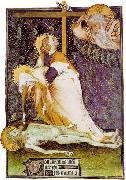Le Pétrole en gros ne Peignant pas de Minimum
|
|
|
|
|
|
|
|
|
|
29 x 80.8 cm Biblioth?que Nationale, Paris The folio is from the so-called "Grandes Heures de Rohan" executed by the Master of the Rohan Prayer-book. The picture fills the whole surface of the folio, and also includes, in a separate little frame, a part of the text. The pale, greyish, angular and thin body of the dead Christ, bleeding from five wounds, lies right on the greenish-brown bare ground. Above Him the deathly pale Virgin opens her arms for a last embrace, but would collapse, fainting, onto her dead Son if St John did not support her with an energetic movement. At the same time St John turns his head with a complaining and reproachful countenance towards the monumental torso of God the Father appearing in the top right-hand corner of the picture. The monumentality of God, descending from heavenly heights to earthly proximity, is further increased by His figure being disproportionately larger than the other three figures. Only His complexion is rosy. In his left hand He is holding the sphere, while the expressions of blessing, of appreciation and of sorrow are blended in the movement of His right arm. The background of the scene is like a tapestry of gold and blue patterns on a black ground. The whirl of angels flying about quickly and the flashing of their golden wings provide the basic mood of the scene as an orchestral accompaniment. The main characteristic of the composition is that, while it is based on a strict geometrical framework, it is pervaded in every respect by sharp contrasts and tensions, which are, however, all resolved by the painter. The moment represented, the transitory state of the fall held back, is fraught with tension; it is somewhat eased by the fact that the tip of the Virgin's fingerjust touches the end of Christ's beard. The four heads emphasized by their haloes are placed on the quarter of an arc, the radius of which is the horizontally placed body of Christ, as if that nadir were attracting the other three figures. It is a nadir, but, at the same time, also a centre of gravity, its solidity being ensured by the fact that both ends of the rigid body not only touch the frame on either side, but that at one point the head and halo even break through it. At both ends of the quarter circle two faces are turned towards each other. The heads of Christ and St John, both with their eyelids closed, are turned to God the Father, while the glance of the Virgin and of God the Father rest on the head of Christ. The bodies of the Virgin and of St John seem to be turning into opposite directions from a common trunk. They are both represented in sharp profile, whereas the heads of God the Father and of Christ are shown from a three-quarter view. , MINIATURIST, French , Lament over the Dead Christ , 1401-1450 , French , illumination , religious |
|
|
|
|
CONTACTER DES Etats-Unis
Xiamen Chine Pétrole en gros Peignant la Barre de Civière Cadre en gros Moulant le Miroir Tableaux Tendus Encadrés |
|








